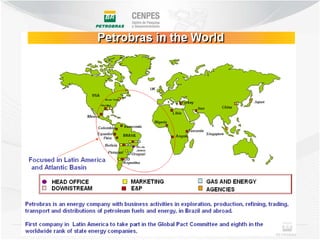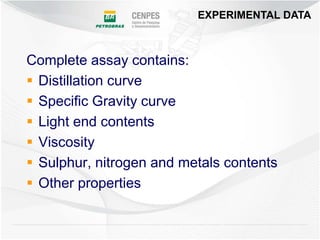Modelling, Simulation and Optimization of Refining Processes
- 1. Modelling, Simulation and Optimization of Refining Processes Jacques Niederberger, M.Sc. PETROBRAS Research & Development Center (CENPES) August/2009
- 2. Summary Introduction Oil characterization Modelling Refining Processes Optimization Aspects
- 3. Introduction: PETROBRAS operations and R&D
- 4. PETROBRAS AN INTEGRATED ENERGY COMPANY Total Investments: 15 Refineries US$ 29 billion in 2008 Installed Capacity: 2.125 million bpd Natural Gas Production: Employees: 74,204 420 thousand boe per day Net Operating Revenues US$ 127 billion (2008) Proved Reserves : Oil Production: 15.1 billion barrels of oil 1,980 thousands barrels per and gas equivalent (boe) day (bpd) of oil and LPG Natural Gas Sales: Gas stations: 6,485 65 million m3/d Thermoeletric Energy Plants : 10 Installed Capacity : 1,912 MW Dec 2004
- 6. PETROBRAS INDUSTRIAL UNITS IN BRAZIL
- 7. R&D EXPENDITURES 2.000 1.750 1.500 1.250 R$ MM 1.000 750 500 250 0 2000 2001 2002 2003 2004 2005 2006 2007 2008 CENPES Ano 137 Laboratories EXAMPLES OF MAIN CHALLENGES 14 TECHNOLOGY PROGRAMS Ultra deep water production technology Production in the Pre-salt sequence Lower environmental impact products Better output products Optimization Pre-salt & Zero discharge / zero emissions processes Reliability
- 8. TECHNOLOGICAL INTEGRATION R&D CENTER Types: Types: Contracts and agreements with Universities Joint Industry Projects and Research Centers Cooperating Research Strategic Alliances National networks of excellence - about Technology Interchange different oil & gas themes Over 120 Brazilian Institutions Over 70 International Institutions
- 10. • What is oil ? • Where does it come from ?
- 11. EXPERIMENTAL DATA Complete assay contains: Distillation curve Specific Gravity curve Light end contents Viscosity Sulphur, nitrogen and metals contents Other properties
- 12. TRADITIONAL CHARACTERIZATION PROCEDURE True Boiling Point Curve - TBP • Product withdraws at constant volume or at constant temperature • Near ideal fractionation • Long time demanded, high cost
- 13. TRADITIONAL CHARACTERIZATION PROCEDURE Crude Oil TBP temperature, C o % vaporized
- 14. TRADITIONAL CHARACTERIZATION PROCEDURE Crude Oil TBP temperature, C o % vaporized
- 15. TRADITIONAL CHARACTERIZATION PROCEDURE Distillation curve, Specific gravity Pseudo-components Characterization Method Pseudo-component: fake component, oil fraction. Crude oil and its derivatives are hydrocarbons mixtures, well described by cubic equations of state (SRK, PR) The characterization method provides pseudo- component properties: Tc, Pc, w, PM, d60, Teb, etc.
- 16. IMPROVED CHARACTERIZATION Instead of pseudocomponents, real molecules. • Group of molecules typically present in a determined fraction • Bulk properties: distillation curve and specific gravity • Mixture composition obtained through an optimization method
- 18. TYPICAL REFINERY SCHEME
- 19. EFFECTS OF THE CHARACTERIZATION METHOD Processes involving chemical reactions: Heavy Feedstock → Gases + Light Distillates + Medium Distillates + unconverted or Heavy Feedstock + H2 → Organic Gases + H2S + NH3 + Light Distillates + Medium Distillates + unconverted
- 20. EFFECTS OF THE CHARACTERIZATION METHOD How to model chemical reactions ? Kinetics x Thermodynamics Kinetics: reaction order, kinetic parameters Thermodynamics: Gibbs free energy
- 21. EFFECTS OF THE CHARACTERIZATION METHOD Either Kinetics or Thermodynamics require pure component data. Pseudo-component approach: not good! Compositional approach: no big deal!
- 22. EFFECTS OF THE CHARACTERIZATION METHOD If we characterize using molecules:
- 23. EFFECTS OF THE CHARACTERIZATION METHOD •How to build phenomenological models of conversion processes dealing with pseudocomponents ? •Relating the overall conversion and product profile to bulk properties of the feedstock and process conditions.
- 24. REFINING PROCESSES MODELLING •We model phase equilibrium and separation process with the traditional tools provided by Thermodynamics •And for the conversion processes we build semi-empirical models
- 25. REFINING PROCESSES MODELLING •Main conversion processes: FCC – fluid catalytic cracking Delayed Coking Hydrotreating HCC – catalytic hydrocracking
- 26. REFINING PROCESSES MODELLING For instance, in the FCC process: Gasoil → Combustible gas + LPG + Naphta + LCO + DO + coke •Overall conversion depends on: feedstock properties catalyst properties hardware geometry process conditions
- 27. REFINING PROCESSES MODELLING •Product profile depends on: feedstock properties catalyst properties hardware geometry process conditions •Product properties depend on: ...
- 28. REFINING PROCESSES MODELLING How do we address any other effect not directly taken into account by the semi-empirical model ? Introducing adjustable tuning parameters in the model. Process data is necessary for fitting the parameters.
- 29. REFINING PROCESSES MODELLING Quality of the model predictions equals the quality of process and feedstock data
- 31. REFINING PROCESSES OPTIMIZATION What does optimization mens ? Generally speaking, any improvement in a process with a few degrees of freedom may be called optimization. From our point of view, optimization is finding THE best solution, in a system with one ore more degrees of freedom.
- 32. SCOPE X TIME SCALE Task Scope Time horizon Planning operations and All the eleven Petrobras’ 5 to 20 years The scope of the optimization problem and invesments for the next refineries the time horizon varies in the same years direction. Designing a new plant One or more units of a 5 years refinery Planning the production One single refinery Monthly, weekly of a sigle industrial plant Optimizing operating Crude distillation + FCC Every 1 or 2 hours conditions of one or converter + FCC more units of a single fractionation section of a plant refinery
- 33. SCOPE X MODEL COMPLEXITY The largerTask scope, the simpler must be the Model type Planning operations and investments for the Linear models (linear the model. next years programming) Planning the production of an entire refinery Linear models (linear programming) Designing a new unit Rigorous mixed integer-non- linear models (MINLP) Optimizing operating conditions of one or Rigorous non-linear models more units of a single plant
- 34. OPTIMIZATION & PROCESS DESIGN Design Synthesis Initial estimates Decision variables Analysis Mass & energy balances Optimization Equipment sizing and cost estimates Parametric Structural Optimization Optimization Economic Evaluation Final Design
- 35. OPERATING CONDITIONS OPTIMIZATION - OFF LINE PROCESS DATA DATA RECONCILIATION RECONCILED PROCESS DATA MODEL TUNING & GROSS ERRORS OPTIMIZATION DETECTION UNIT MAINTENANCE PROCESS ENGINEER CONTROL SYSTEM OPERATOR
- 36. PROCESS AUTOMATION HIERARCHY
- 37. OPERATING CONDITIONS OPTIMIZATION - RTO Many plants don’t have a much stable operation. Optimal conditions for one determined run may not be the best for another run. If optimization is off-line, we need to re-optimize for every different run.
- 38. OPERATING CONDITIONS OPTIMIZATION - RTO Imagine if we had an optimization machine that could read process data at real time, tune automatically the process model, run automatically the optimization problem and send automatically the optimal conditions for the digital control system … That would be Real Time Optimization - RTO.
- 39. RTO STRUCTURE Hibernation Steady State Detection No Stationary ? Yes Model tuning Optimization No Solution obtained? Yes New setpoints for the control system
- 40. RTO benefits Real Time Optimization PETROBRAS experience: RTO implemented on Distillation and FCC Units using Equation Oriented and Sequential Modular approaches
- 41. RTO benefits Real Time Optimization FCC Example: Operational modifications (Reaction temperature, Feed temperature and Main Fractionator top reflux) due to RTO
- 42. RTO Challenges RTO runs only when the unit is Steady but what is Steady State? commercial applications use a kind of statistical approach (mean, std dev, Student and F-test) along with some heuristics (“tuning factor”) on a set of the most representative variables (temperatures and flow rates linked to the unit heat and mass balance) do we really have to wait Steady-State? it can take 1-2 hours between runs if a disturbance enters the unit in between no RTO run maybe for a long period Change the “tuning factor” or improve APC / Regulatory control
- 43. RTO Challenges Real Time Optimization How to deal with the “unknown” feed composition (especially in Distillation)? Online analyzers NMR or NIR? Lab analysis frequence? Methods? Feed Reconciliation as long as you have confidence on the model, use it as an analyzer Redistribute the amount of the pseudocomponents in order to match some information from the unit (operations and product quality) It is an optimization problem maybe the most difficult one (more than the profit optimization)
- 44. RTO Challenges Real Time Optimization Non convergence tracking: it is a hard task, sometimes, to find out the origin of the failure, especially, when it is not associated with instrumentations or well-known process problems Initialization techniques Scaling: heuristic rules X numerical analysis of the system Integrating multiple process unities: how to deal with the increasing problem size to get the most of integrated unities optimization and its flexibilities? How to deal with non convergence?
- 45. RTO Challenges Real Time Optimization Entire plant rigorous RTO – feasible, but still not possible Multi-scale Optimization: integration and information exchange between different optimization levels is an issue that demands more attention Dynamic RTO: it is still an open issue Computational efforts? Numerical issues? How to implement it on industrial applications?
- 46. Questions ?














































